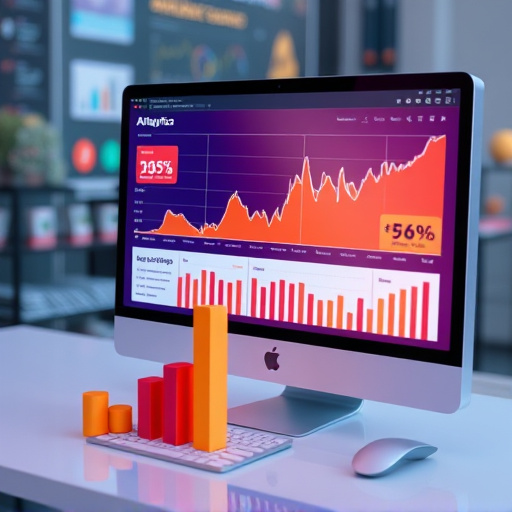In the dynamic e-commerce sector, data-driven decisions and strategic web design are crucial for success. By leveraging analytics tools, retailers gain insights into customer behavior, enabling personalized experiences that boost conversions and satisfaction. Modern e-commerce web design is data-powered, with SEO strategies enhancing website traffic and visibility. Key metrics like conversion rates, bounce rates, average session duration, and page views per visit are vital for improvement. Optimizing for mobile devices further enhances usability and Google Business Profile rankings. Engaging professional web design services specializing in e-commerce can significantly elevate success in today's competitive landscape, reshaping user experience through data-driven strategies.
In the dynamic landscape of e-commerce, data-driven decisions are no longer a luxury but a necessity. This article explores how leveraging data can revolutionize your e-commerce web design strategy. We delve into the power of insights, revealing key metrics to guide informed choices that enhance user experience and drive business growth. By implementing data-backed strategies, you can navigate the digital market effectively, ensuring your online store stands out in a bustling competitive environment.
- Understanding the Power of Data in E-Commerce Web Design
- Key Metrics to Consider for Informed Decision Making
- Implementing Data-Driven Strategies for Enhanced User Experience and Business Growth
Understanding the Power of Data in E-Commerce Web Design

In the dynamic landscape of e-commerce, understanding customer behavior and market trends is no longer an option but a necessity. Data-driven decisions are revolutionizing the way businesses approach their online presence, particularly in e-commerce web design. By leveraging analytics tools, retailers can gain valuable insights into consumer patterns, preferences, and interactions with their websites. This knowledge allows for the creation of tailored experiences that resonate with specific target audiences, ultimately leading to increased conversions and customer satisfaction.
Web design near me has evolved from a purely aesthetic endeavor to a strategic process powered by data. SEO-focused strategies play a pivotal role in enhancing website visibility and driving organic increase website traffic. Companies like an SEO company Plano can assist in optimizing sites for search engines, ensuring that the right customers find the right products at the right time. Through continuous analysis and refinement, e-commerce businesses can stay ahead of the curve, offering user-centric designs that not only attract but also retain shoppers in today’s competitive digital marketplace.
Key Metrics to Consider for Informed Decision Making

When crafting a data-driven e-commerce web design strategy, several key metrics are essential for making informed decisions that boost sales and enhance customer satisfaction. Firstly, tracking conversion rates provides insights into how effectively your website persuades visitors to make purchases. By analyzing user behavior through tools like Google Analytics, you can identify bottlenecks in the checkout process or areas where potential customers abandon their carts. Secondly, keeping a close eye on bounce rates helps gauge the level of engagement with your web pages. A high bounce rate might indicate that content isn’t resonating with visitors, while a low one suggests they’re finding what they need quickly.
In addition to these, monitoring average session duration and page views per visit offers valuable context about user interaction. These metrics can guide decisions on content optimization, product presentation, and overall website structure. Furthermore, considering the increasing importance of mobile shopping, ensuring your web design is optimized for various devices—including smartphones and tablets—is crucial. This not only enhances usability but also contributes to better Google Business Profile optimization, as search engines favor mobile-friendly websites in their rankings. Engaging with web design services that cater to these needs can significantly impact your e-commerce success.
Implementing Data-Driven Strategies for Enhanced User Experience and Business Growth

In the competitive landscape of e-commerce, data-driven strategies are transforming how businesses approach web design and user experience (UX). By leveraging insights from customer behavior analytics, companies can create tailored digital environments that not only captivate visitors but also drive conversions. Implementing data-informed decisions allows for a deeper understanding of target audiences, enabling website design agencies to optimize layouts, content placement, and navigation flows accordingly. This strategic approach ensures that every element on an e-commerce webpage serves a purpose, ultimately enhancing user engagement and fostering brand loyalty.
Moreover, integrating SEO marketing services into this data-centric framework can significantly boost local search visibility. Well-optimized websites, backed by comprehensive analytics, are better equipped to rank higher in search engine results pages (SERPs), attracting organic traffic. As users navigate through a seamless, data-driven e-commerce web design, they are more likely to explore products, share their experiences, and contribute to the overall growth of the business. This positive feedback loop ensures that both user satisfaction and business objectives are met simultaneously.
Data-driven decisions are revolutionizing e-commerce web design, enabling businesses to create tailored experiences that drive growth. By understanding key metrics and implementing data-informed strategies, retailers can optimize their online presence, enhance user engagement, and ultimately achieve sustainable success in the competitive e-commerce landscape. This data-centric approach ensures that every element of the website, from product display to checkout processes, is designed with a clear purpose, leading to improved conversions and customer satisfaction.














